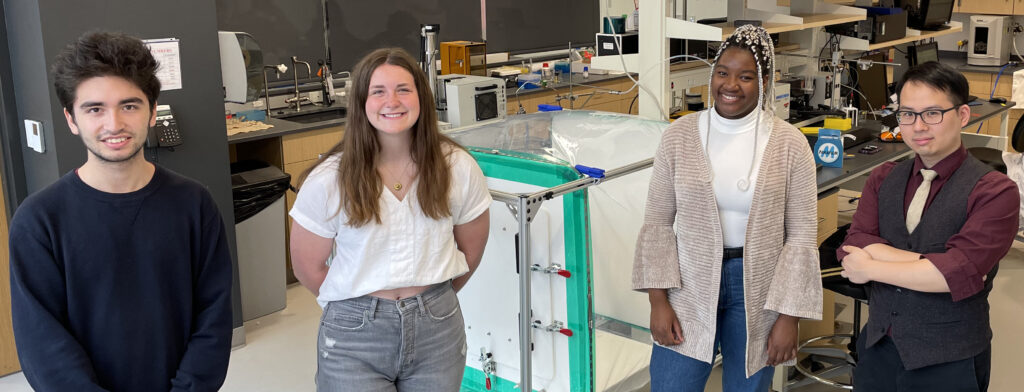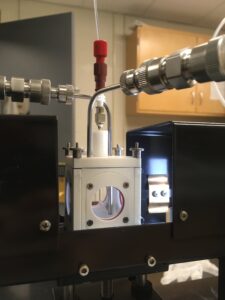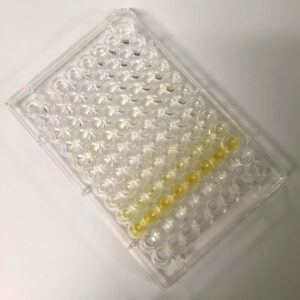
The chemistry that occurs within atmospheric aerosols – small particles or droplets in the atmosphere – is a major sticking point in current understanding of climate change mechanics. While the heating and cooling effects of many atmospheric phenomena have been estimated with good certainty, the effect of aerosols remains poorly characterized and as a result contributes the largest source of inaccuracy to atmospheric models. Research at Lafayette aims to increase the understanding of the physical effects of several relevant atmospheric volatile organic compounds on atmospheric aerosols, via a combination of experimental and computational techniques.
In-Situ Surface Properties of Atmospheric Aerosol Mimics
 The overall concentrations of surface active organic compounds may not be representative of their actual concentration at aerosol surfaces – which can lead to under-prediction of their properties and effects in existing climate models. In our group, we measure the surface properties of systems that emulate the high surface-volume ratio of aerosols. By better understanding their behavior and chemistry, we can better estimate how aerosols change the overall energy balance in the atmosphere.
The overall concentrations of surface active organic compounds may not be representative of their actual concentration at aerosol surfaces – which can lead to under-prediction of their properties and effects in existing climate models. In our group, we measure the surface properties of systems that emulate the high surface-volume ratio of aerosols. By better understanding their behavior and chemistry, we can better estimate how aerosols change the overall energy balance in the atmosphere.
Current Students:
- Ava Battalgia, Class of ’27
- Michael Haines, Class of ’26
- Kira Baker, Class of ’27
Former Students:
- Daphna Fertil, Class of ’22
- Emily Cotter, Class of ’21
- Thomas Beier, Class of ’19
Publications:
- “Surfactant Effects in Irradiated, Hanging-Droplet, Aqueous-Phase Glyoxal/Ammonium Sulfate Aerosol Mimic Systems.” D Fertil, K Pierre-Louis, S Ingwer, MM Galloway, JL Woo. ACS Earth and Space Chem. 9 (3) 524-532 (2025.) (Link to paper)
- “In Situ Surface Tension Measurements of Hanging Droplet Methylglyoxal/Ammonium Sulfate Aerosol Mimics under Photooxidative Conditions” T Beier, ER Cotter, MM Galloway, and JL Woo. ACS Earth and Space Chem. 3 (7) 1208-1215 (2019). (Link to paper)
Continuous-Flow Chamber Characterization of Lab-Generated Aqueous Aerosols
 The Lafayette College continuous-flow atmospheric chamber provides a small (~1m3) but controlled volume where air and aerosol composition can be precisely set. Generated aerosols can be introduced into this controlled environment and subsequently collected as they exit. Through the characterization of these collected aerosol (e.g., light absorbing behavior, surface tension, etc.) our group is able to infer trends in physical property shifts when aerosols are exposed to different ambient conditions.
The Lafayette College continuous-flow atmospheric chamber provides a small (~1m3) but controlled volume where air and aerosol composition can be precisely set. Generated aerosols can be introduced into this controlled environment and subsequently collected as they exit. Through the characterization of these collected aerosol (e.g., light absorbing behavior, surface tension, etc.) our group is able to infer trends in physical property shifts when aerosols are exposed to different ambient conditions.
This work was made possible through a grant through the National Science Foundation. (ERI 2138346.)
Current Students:
- None.
Former Students:
- Kitty Pierre-Louis, Class of ’23
- Erin O’Leary, Class of ’25
- Bruno Loyola San Martin, Class of ’25
- Maia Merriman, Class of ’26
Decomposition of Dynamic Chromophoric Behavior in Aqueous Aerosol Mimics
 The light absorbing behavior of aerosols is of interest to the atmospheric science community as it contributes a net warming effect to overall atmospheric energy balances. Specific interest falls on a class of secondary organic aerosol (SOA) compound known as Brown Carbon (BrC), so denoted due to its light-absorbing properties in the high-visible to ultraviolet range of light. Brown carbon species can form in significant quantities through aqueous carbonyl chemistry in the presence of ammonium salts. However, the exact compounds and number of different reaction products that form are not well-characterized, due to their structural similarities and large numbers. Our modeling work aims to side-step exact chemical mechanistic details, and instead attempts to numerically fit multiple datasets of absorbance spectra versus time, as a function of the concentration of precursor materials that originally led to these products’ formation.
The light absorbing behavior of aerosols is of interest to the atmospheric science community as it contributes a net warming effect to overall atmospheric energy balances. Specific interest falls on a class of secondary organic aerosol (SOA) compound known as Brown Carbon (BrC), so denoted due to its light-absorbing properties in the high-visible to ultraviolet range of light. Brown carbon species can form in significant quantities through aqueous carbonyl chemistry in the presence of ammonium salts. However, the exact compounds and number of different reaction products that form are not well-characterized, due to their structural similarities and large numbers. Our modeling work aims to side-step exact chemical mechanistic details, and instead attempts to numerically fit multiple datasets of absorbance spectra versus time, as a function of the concentration of precursor materials that originally led to these products’ formation.
Current Students:
- None.
Former Students:
- Maxine Nwosu, Class of ’22
- Shiqing Ma, Class of ’21
- Nahin Ferdousi, Class of ’19
- Mengjie Fan, Class of ’18
- Ziwei Dai, Class of ’18
Publications:
- “Competing Photochemical Effects in Aqueous Carbonyl/Ammonium Brown Carbon Systems.” JR Sharp, DN Grace, S Ma, JL Woo, and MM Galloway. ACS Earth and Space Chem. 5 (8) 1902-1915 (2021). (Link to paper)
- “Brown Carbon Formation Potential of the Biacetyl-Ammonium Sulfate Reaction System.” DN Grace, EN Lugos, S Ma, DR Griffith, HH Hendrickson, JL Woo, and MM Galloway. ACS Earth and Space Chem. 4 (7) 1104-1113 (2020). (Link to paper)
- “Modeling of Carbonyl/Ammonium Sulfate Aqueous Brown Carbon Chemistry via UV/Vis Spectral Decomposition.” M Fan, S Ma, N Ferdousi, Z Dai, JL Woo. Atmosphere 11(4), 358-373 (2020). (Link to paper)
Interaction Effects of Ultrafine Particle Emissions of 3D Printers
 Fused-deposition modeling (FDM), one of the most commonly-employed forms of 3D printing, has been of particular interest to the indoor air/atmospheric sciences field. Its mechanism of driving a plastic filament through a high-temperature metal nozzle to construct objects creates a point source of gaseous low-volatility organic compounds (i.e. molten/vaporized plastic products) at the tip of the nozzle, which then rapidly condense into aerosols as they diffuse away from the print head. Literature has only recently begun to explore the effects of FDM printers on indoor atmospheric air quality, including aerosol emissions, concentrations, and size distributions. Of note, papers have previously explored the emission characteristics of single printers using various materials, surroundings, and operating conditions. Our work at Lafayette explores the interactions in emissions and prevailing concentrations of aerosols generated through multiple 3D printers in close proximity.
Fused-deposition modeling (FDM), one of the most commonly-employed forms of 3D printing, has been of particular interest to the indoor air/atmospheric sciences field. Its mechanism of driving a plastic filament through a high-temperature metal nozzle to construct objects creates a point source of gaseous low-volatility organic compounds (i.e. molten/vaporized plastic products) at the tip of the nozzle, which then rapidly condense into aerosols as they diffuse away from the print head. Literature has only recently begun to explore the effects of FDM printers on indoor atmospheric air quality, including aerosol emissions, concentrations, and size distributions. Of note, papers have previously explored the emission characteristics of single printers using various materials, surroundings, and operating conditions. Our work at Lafayette explores the interactions in emissions and prevailing concentrations of aerosols generated through multiple 3D printers in close proximity.
Current Students:
- None.
Former Students:
- Nahin Ferdousi, Class of ’19